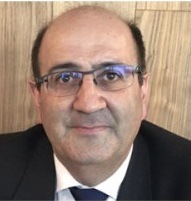This advertorial is sponsored by Boston Scientific and is only intended for readers in Europe.

Fast-acting sub-perception therapy (FAST™)—a novel innovation in the field of spinal cord stimulation (SCS), developed by Boston Scientific—is designed to deliver profound, paraesthesia-free pain relief in a matter of minutes. José F Paz-Solís (La Paz University Hospital, Madrid, Spain) sits down with NeuroNews to discuss some of the promising results FAST has demonstrated in early studies, and how these findings could translate to life-changing benefits for patients.
Z
When did you first hear about FAST therapy for pain relief, and why were you interested?
When I visited Valencia in the USA at the end of 2018, I talked with Que Doan (Boston Scientific Neuromodulation, Clinical and R&D departments, Valencia, USA). He presented me this novel therapy and then we started with several patients in the summer of 2019—with excellent results. I was very excited about it because I really understood the mechanisms well, and the applications of it. I really believed that this new mechanism of action (MoA1) could help a huge number of patients with chronic pain demanding a rapid onset of analgesia.
In general, what were the key findings of the review published in Expert Review of Medical Devices earlier this year—which you co-authored—and why were they significant?
The first impactful finding was that we noticed that, when patients were stimulated with such high-resolution electrical fields combined with a paraesthesia-based biphasic waveform, they had almost instant pain relief. Also, these patients reported profound analgesia within minutes of stimulation set to sub-perception levels—something rarely seen before. It is important to note that this new programming modality, despite being sub-perception, does not require a high-energy consumption, which is something that is not always considered but is extremely comfortable for the patient. So far, we have studied more than 45 patients in our centre implanted with the Boston Scientific WaveWriter Alpha and, in many of them, we have already begun the intraoperative or operative phase of implantation to test FAST therapy—with very spectacular results.
What benefits have you observed when using FAST therapy—in terms of immediate or improved pain relief?
The straightforward benefit is the time you save trying to find pain relief in your patients. In the past, we used to programme several options and have the patient try them in order to look for the best programming. Now, we programme FAST and we see—within minutes— almost immediate results. And, although more work needs to be done in this direction, we may also be able to use this kind of programming to determine if patients respond to SCS in a faster way, and use it in the trial phase or even introduce the use of “all-in-one” (single-stage) implants in well-selected patients, avoiding the costs related to hospital admissions, second-stage surgeries etc.
From the patient’s point of view, are there any other benefits you feel it holds?
When the patient does not notice paraesthesia and, yet, they do notice a profound relief of their pain, it is likely that at times they will forget that they have an implant. This could enable them to lead a normal and more satisfactory life. The fact that chronic pain patients can resume their lives with almost total normality is what empowers us to continue researching and working on improving all programming options. I believe that, with FAST, we have achieved an important milestone in this regard.
Does FAST enable any specific advantages for the clinician using it—particularly compared to other pain-relief therapies?
The best thing about this option is that I can obtain rapid analgesia in patients who have either lost their relief or have not obtained it in any great totality. Thanks to FAST, we can better identify the specific areas of better-targeted stimulation for long-term pain relief, and see if the therapy is working or not in minutes.
Moving forward, what impact could this new technology have on the broader field of pain relief?
The impact could be huge! Imagine if you could have a normal painkilling drug like ibuprofen with immediate action—meaning, for example, your headache is gone in a matter of two minutes. FAST analgesia in SCS is exactly this. Designed immediate pain relief through electrical stimulation. This is something incredibly innovative that does not exist in any other treatment, not only those dedicated to treat pain. However, we commented in our paper in Expert Review of Medical Devices2 that future studies should be developed to better understand different MoAs and their potential benefits in the long term.
What do you think the next steps will be in researching the safety and effectiveness of FAST?
FAST is still in the early stages, so proving long-term sustained outcomes is necessary. The ability to progressively save even more energy for patients could also be fantastic, although the energy settings so far are very good, with weekly charging. FAST is now expanding the therapy options available in the Boston Scientific WaveWriter Alpha portfolio and the flexibility of the platform will allow identification of the best therapy for every unique patient, based on their own responses to the stimulation.

References:
- FAST MoA computational modelling by Dr Warren Grill’s lab at Duke University. Gilbert et al. Computational modelling predicts dorsal columns are involved in fast-acting sub-perception spinal cord stimulation (SCS). Warren SFN 2021.
- Metzger C S, Hammond M B, Paz-Solís J F, et al. A novel fast-acting sub-perception spinal cord stimulation therapy enables rapid onset of analgesia in patients with chronic pain. Expert Rev Med Devices. 2021;18(3): 299–306.
José F Paz-Solís is a neurosurgeon at La Paz University Hospital in Madrid, Spain.
A closer look at the FAST mechanism of action
Many of the clinical benefits seen in early investigations of FAST are enabled by the novel MoA it is built around—referred to as the “surround-inhibition effect”. “Surround inhibition arises from the centre-surround organisation of receptive fields that is present throughout sensory systems,” states Warren M Grill, a professor of biomedical engineering at Duke University (Durham, USA). “For example, in the retina, stimuli delivered in the centre of the receptive field produce activation of the neuron, while stimuli delivered in the surrounding area produce inhibition of the neuron. A similar organisation is present in the somatosensory system. FAST stimulates sensory fibres (dorsal column axons) originating from the surrounding area—through a combination of spatial targeting and stimulation-parameter selection— thereby producing inhibition of the pain-transmitting neuron, and resulting in pain relief.”

According to Grill, this differs from the MoA harnessed by other SCS therapies, which also activate dorsal column axons, but do so in a way that originates from the centre of the receptive field. The key distinction here is that activating these fibres in this way causes “a mix of activation and inhibition of pain-transmitting neurons”—thus producing modest reductions in pain intensity and, simultaneously, inducing a tingling or buzzing sensation known as paraesthesia, which is a bothersome side-effect for some patients. The MoA seen in FAST, however, does not suffer from these same limitations, and produces a “rapid onset of profound pain relief” without any paraesthesia, Grill claims.
“The rapid onset of pain relief produced by FAST enables the physician to quickly assess the degree of benefit that their patient is receiving from the therapy,” he adds. “Further, the prescribed stimulation parameters—the neural dose— means that the physician does not have to spend time searching for the parameters that produce the most pain relief.” Grill also states that, because this surround-inhibition effect is present throughout the somatosensory system, the applications of the MoA deployed by FAST may stretch beyond SCS, with “appropriate spatial targeting and stimulation-parameter selection” providing the ability to stimulate these nerve fibres selectively.
DISCLAIMER: Results from different clinical investigations are not directly comparable. Information provided for educational purposes only.
CAUTION: The law restricts these devices to sale by or on the order of a physician. Indications, contraindications, warnings and instructions for use can be found in the product labelling supplied with each device. Products shown for INFORMATION purposes only and may not be approved or for sale in certain countries. This material not intended for use in France. 2021 Copyright © Boston Scientific Corporation or its affiliates. All rights reserved. NM-1112001-AA.
IMPORTANT INFORMATION: These materials are intended to describe common clinical considerations and procedural steps for the use of referenced technologies but may not be appropriate for every patient or case. Decisions surrounding patient care depend on the physician’s professional judgment in light of all available information for the case at hand. Boston Scientific (BSC) does not promote or encourage the use of its devices outside their approved labelling. Case studies are not necessarily representative of clinical outcomes in all cases as individual results may vary.












